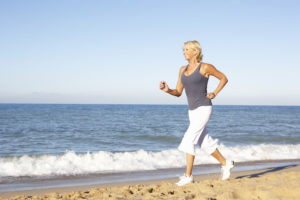7 tips that healthy women can adopt at any age for a long-lasting, happy life
1. Simple Exercise to help women stay healthy
Even a little bit of exercise is more beneficial than absolutely none. If you have an injury or illness or are just unfit, take a walk around your home or property. If you cannot walk, then try a seated arm or shoulder exercise, lifting your arms up while keeping your back and shoulder muscles from stiffening. Another great exercise if you can’t walk, is to move your legs and feet slightly, improving your circulation, and ensuring that dangerous blood clots don’t occur. You can also try to squeeze the muscles in your bottom for some added exercise. While you should always accept help when you need it, it is good to retain physical independence. Just keep your steps long and even and stop if your lower back or pelvic area start to feel tired.
2. Avoid sitting still for too long
Every half hour of being stationary must be broken up by a minute of moving or walking around. It will keep your buttock muscles from weakening, which will make standing easier and help prevent pain in your lower back. This helps because your body’s tissues and its muscles can remember a position, so if you keep a position for too long, it will be harder to straighten out afterwards.
3. Keep your bones strong with exercises
Keep your bones strong with exercises that makes your body bear a load
Exercise that places weight on your bones will reduce your chances of developing osteoporosis. You can use hand held weights or complete push ups using a bench surface to strengthen your arm, back and shoulder bones. Walking will strengthen hip joints as well as leg bones without exacerbating back pain, while also boosting the muscles on the floor of the pelvis.
4. Walk upright
Having a good posture is critical to your balance, which in turn will keep you from falling. It benefits the pelvic floor when your central muscles are activated, keeping your belly tucked in. It’s easy to practice this throughout the day and, as a bonus, it will make you look taller and younger.
5. Exercise the muscles of your pelvic floor
At Graceville Physio, we strongly believe that the muscles of the pelvic floor are one of the most important in a woman’s body. It’s a muscle that benefits from the previously mentioned exercises and activities, as well as by doing specific pelvic floor exercises. As many women know, a weak pelvic floor can create bowel or bladder incontinence, but few understand exactly why.
Your pelvic floor muscles form a hammock that keeps internal organs in place within your abdomen, and when this muscle is contracted or lifted these organs are in turn lifted, preventing them from prolapsing. It also works to stabilise your lower back, as activating this area tilts your tailbone, stabilising your lower spine.
Prolapsing can occur in the bladder, bowel or uterus and in addition to being embarrassing and life altering, can even require surgical intervention in order to hoist these organs back to their right place in absence of a fully functional pelvic floor.



